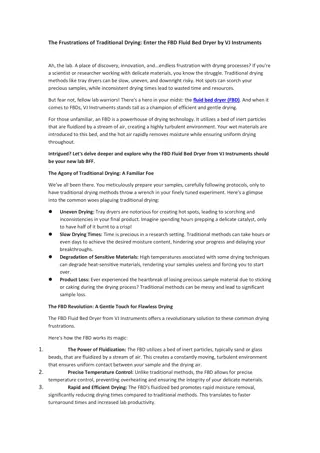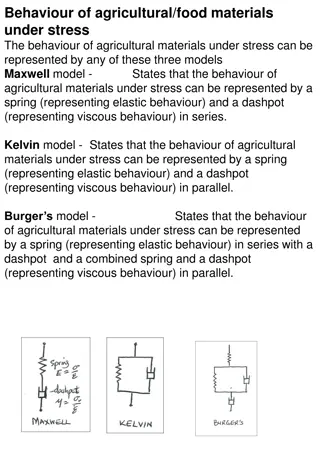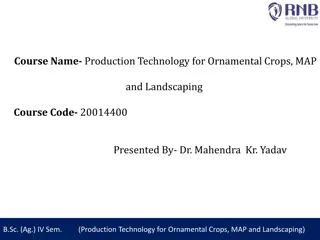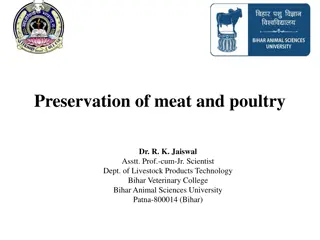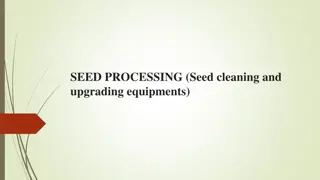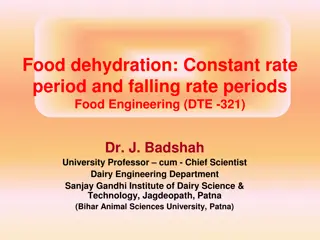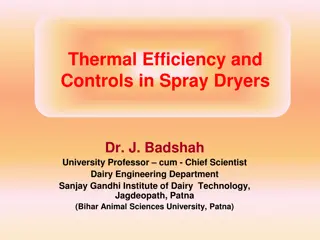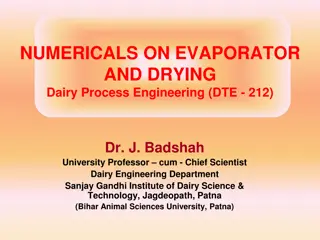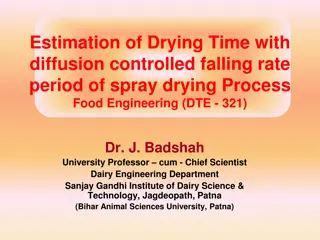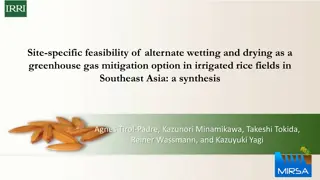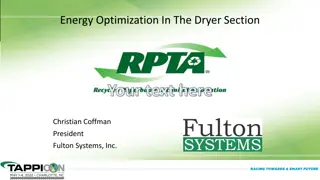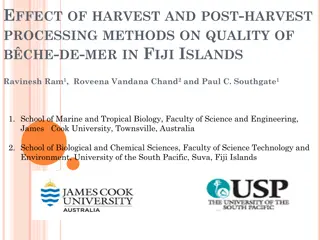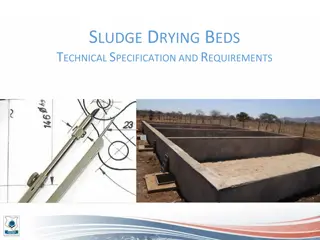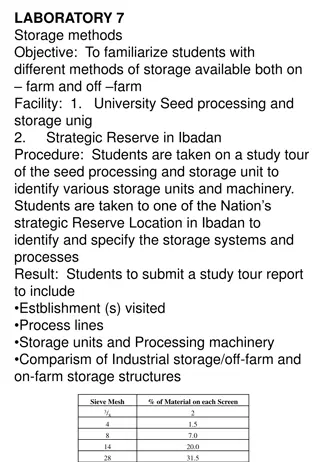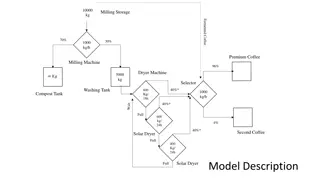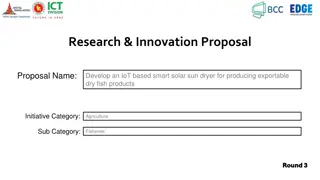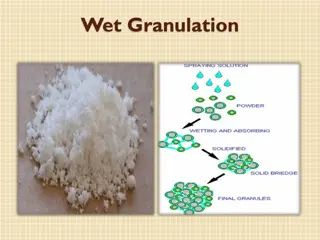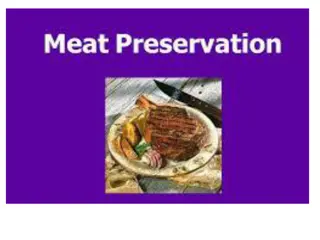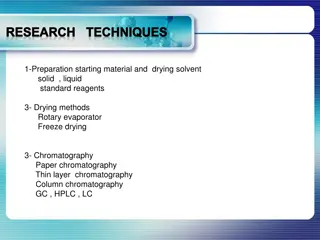Understanding Drying Principles and Applications
Drying is the process of removing liquid from a material using heat, with various methods such as thermal and non-thermal approaches. This article explores the definition, purpose, and psychrometry of drying, along with the significance of drying in different industries like pharmaceuticals. Additionally, it delves into the concept of psychrometric charts and their role in determining humidity levels.
Download Presentation

Please find below an Image/Link to download the presentation.
The content on the website is provided AS IS for your information and personal use only. It may not be sold, licensed, or shared on other websites without obtaining consent from the author. Download presentation by click this link. If you encounter any issues during the download, it is possible that the publisher has removed the file from their server.
E N D
Presentation Transcript
DRYING Lec. Sura Zuhair Alkazzaz
DEFINITION: Drying is the removal of small amount of a liquid from a material by the application of heat which is transferred from a surface into an unsaturated vapor phase. Drying and evaporation are distinguishable merely by the relative quantities of liquid removed from the solid. Non-thermal methods of drying are: The expression of a solid to remove liquid by (the squeezing of a wetted sponge), The extraction of liquid from a solid by use of a solvent, The adsorption of water from a solvent by the use of desiccants (such as anhydrous calcium chloride), The absorption of moisture from gases by passage through a sulfuric acid column, The desiccation of moisture from a solid by placing it in a sealed container with a moisture-removing material (silica gel in a bottle).
Purpose of drying: In the preparation of granules in tablets and capsules. In the preparation of dried aluminium hydroxide, the spray drying of lactose, and powdered extracts. Reduces the bulk and the weight of drying materials (lowering the cost of transportation and storage). Aids in the preservation of animal and vegetable drugs by minimizing mold and bacterial growth. Removing the moisture facilitates comminution and becomes more friable. Dried products are more stable such as effervescent salts, aspirin, hygroscopic powders, ascorbic acid, and penicillin; through reducing the chemical reactivity.
Psychrometry Psychrometry determines the vapor concentration and carrying capacity of the gas. Vapor-carrying capacity of the air, nitrogen, or other gas stream passing over the drying material. The carrying capacity determines the rate and the extent of drying material (the lowest moisture content). The concentration of water vapor in a gas is called the humidity of the gas.
Psychrometric or humidity chart represents the relationship between the temperature and humidity of the air-water vapor system at constant pressure.
The temperature represents the horizontal axis and absolute humidity represents the vertical axis (the weight of water vapor per unit weight of dry air). CDE curve is the saturation humidity (absolute humidity) at which the partial pressure of water vapor in the air = the vapor pressure of free water at the same temperature. The air is completely saturated with moisture, and the humidity does not change when it is in contact with liquid water at the same temperature that means 100% relative humidity (RH) It is boundary of a phase diagram, any point on the curve can determine either by the temperature or the absolute humidity.
FCA dotted line is the absolute humidity (78 grains water/pound dry air); which represents relationship between (T and P). Dew point C (60 F), the air is saturated with water vapor; dew point is the temperature of (air-water vapor mixture) which is cooled to become saturated (maximum amount of moisture without condensation). Point F (50 F), when the mixture is cooled below the dew point; the water vapor condenses into a two-phase system of saturated air (point C) and droplets of free water. Point A (81 F), the air is not completely saturated at (A) which is used for drying purposes (without changing in FCA). Point (A) = FCA (78)/ CDE at point E(161)= 48%.
The relative saturation (percent relative humidity) is the partial pressure of water vapor in the air to the vapor pressure of free water at the same temperature. GK with 50% relative humidity Curves of (T vs H) at a constant (RH) of a specific intervals such as GK curve with 50% (HR). The relative saturation represents the ratio of the absolute humidity(FCA) to saturation humidity (CDE) at the same temperature.
Note If air, at point A (81 F), is used to dry a wet material; the difference in vapor pressure between the surface water and the air leads to evaporate some of the liquid, which may cools the surface below the air temperature The heat is transferred from the Air to the liquid at rate proportional to the temperature difference. This is called wet bulb temperature; define as equilibrium of heat transfer between air-liquid.
Wet-bulb temperature is measured by thermometer (bulb is covered by wick saturated with water). Dry-bulb temperature (actual air temperature) is measured by ordinary thermometer.
The rate of evaporation is related to the rate of heat transfer by the equation : dW/d =q/ Where (dW/d ) is the rate of evaporation, (q) is the overall rate of heat transfer and ( ) is the latent heat of vaporization. The driving force for heat transfer is temperature differential. The rate of diffusion of moisture into the air stream is expressed by the equation: dW/d =k A(Hs-Hg) Where dW/d is the rate of diffusion expressed as pounds of water per hour, k is coefficient of mass transfer, A is the area of evaporating surface , (Hs Hg) is humidity differential.
The coefficient of mass transfer is not constant but varies with the velocity of the air stream passing over the evaporating surface. After initial period of adjustment the rate of heat transfer will equal to the rate of mass transfer. dW/d =q/ =k A(Hs-Hg) The rate of heat transfer include all method of heat transfer which is convection, radiation and conduction From these equations we can conclude that: The rate of drying may be accelerated by increasing ;(The general principle for efficient drying)
1- The rate of convection of heat transfer which can be achieved by increasing the air flow rate and by raising the inlet air temperature. 2- The rate of radiation heat transfer 3- The rate of conduction can be increased by reducing the thickness of the material to be dried (large surface area)by allowing it to become in close contact with raised temperature surface. 4- Increasing the air velocity also speed up the rate of drying by increasing the coefficient of mass transfer(sufficient turbulence to minimize boundary layer thickness) 5- Dehumidifying the inlet air increase the humidity differential also speed up the rate of drying(low relative humidity)
Drying of Solids The moisture in a solid is represented as a wet weight or dry-weight. Wet-weight, the water content is a percentage of the weight of the wet solid.(wt of water in sample / wt of wet sample) Dry-weight, the water content is a percentage of the weight of the dry solid. (wt of water in sample / wt of dry sample) Loss on drying (LOD) is calculated by using %LOD=[(wt of water in sample/wt of wet sample)] 100 Moisture balance is has heat source, the weighted wet sample allowed to dry and obtain %LOD. Moisture Content The moisture content in the sample is determined on a dry- weight basis, as shown in %MC=[(wt of water in sample/wt of dry sample)] 100
Behavior of Solids during Drying/Rate of Drying The study of drying rate is crucial to understand the solid behavior during drying. Rate of drying could be determined by suspending the wet sample on a scale in a drying cabinet and measuring the weight of dry sample as a function of time. The data from drying rate is plotted as moisture content versus time. 1. Drying rate vs moisture content 2. Moisture content vs drying time After a period of initial adjustment; Heating rate=Cooling rate till drying temperature stabilizes. This period of initial adjustment is shown as segment AB in Figures A and B.
B (the temperature stabilized) as long as there is a moisture film at the surface of the drying solid. BC (constant rate period), the moisture evaporating from the surface is replaced by water diffusing from the interior of the solid (Evaporation rate= Diffusion rate) of evaporation. C (critical moisture content), no more moisture is replaced and dry spot appears; (Drying rate falls off). C-D (first falling rate period or the period of unsaturated surface drying), the spots number increases (Drying falls steadily). D (second critical point), complete evaporation of surface film (Drying rate depends on diffusion rate). D-E (second falling rate period), drying rate falls rapidly. E (equilibrium moisture period begins), drying rate=Zero ; the temperature and moisture content remain constant. Continued drying after this point is a waste of time and energy
Classification of Solid Based on Drying Behavior Solids to be dried may be classified based on their drying behavior into: 1)crystalline solids in which the water is held in open surface pores and interstitial spaces between particles which are easily accessible to the surface. 2)amorphous solids, the moisture here is integral part of the molecular structure and entrapped in fine capillaries and pores, accordingly it is difficult to dry than crystalline solids.
Types of Dryers When considering how to dry a material , certain points should be considered: 1- Heat sensitivity of the material to be dried 2- Physical nature of the material 3- Nature of liquid to be removed 4- The scale of operation Dryers can be classified based on method of heat transfer or method of sample handling In the first classification dryer design and energy requirement are important while in the second attention given to the type of the substance to be dried.
In the method of sample handling the presence or absence of agitation is the major criterion: 1.Static-bed dryers 2.Moving-bed dryers 3.Fluidized-bed dryers 4.Pneumatic dryers
Static Bed System Tray dryer consist of cabinet shelf or compartment in which the material to be dried is spread on trays. There is no particles movement; only the bulk motion , the exposed surface can be increased by decreasing the thickness of the bed.
Moving-Bed Systems Turbo-Tray Dryers. This type is a continuous shelf, moving-bed dryer; consists of series of rotating annular trays arranged in a vertical stack_x005F_x005F_x0002_Rotating slowly at 0.1 to 1.0 rpm. -Heated air is circulated by turbo-type fans mounted in the stack center. -Wet mass fed from the roof of dryer; which leveled by a stationary wiper, then the dried material is pushed through radial slots onto the tray below. After each cycle the mass transfers to the next shelf until discharge at the bottom. -Drying rate is faster than tunnel-dryer due to the continuous exposes to the air.
Fluidized-Bed Systems The solids are partially suspended in the gas stream (the mixture behaves like a liquid) and the solid is fluidized. The fluidization technique is used for drying granular solids, as each particle is surrounded by the drying gas. The intense mixing results in uniform conditions of temperature, composition, and particle size distribution throughout the bed. The resultant granules are not wet nor completely dried to avoid cracking.
Advantages of Fluidized Bed Dryer High drying rate due to efficient heat and mass transfer The drying occur at constant rate because all the surface of particles subjected to heat uniformly More spherical free- flowing particles can be obtained reduce the problems of aggregation and migration of color.
Pneumatic Systems A. Spray Dryers It can handle only fluid materials such as solutions, slurries, and thin pastes. Feeding of fine droplets of fluid is into the hot gas stream. The dried powder is carried by the gas current and gravity flow to the collection system. When the liquid droplets contact the hot gas,the surface liquid is quickly evaporated, and form a tough shell of solids. The diffusion rate of the liquid is slower than heat transfer. The internal pressure causes the droplet to swell, and the shell becomes thinner, allowing faster diffusion. If the shell is nonelastic or impermeable, it ruptures, producing either fragments or budlike forms. Thus, spray-dried material consists of intact spheres, spheres with buds, ruptured hollow spheres, or sphere fragments
B. Spray drying and spray congealing of pharmaceuticals. Spray drying is rapid drying and the unique form product. There are three major uses (1) drying heat-sensitive materials, (2) changing the physical form of materials (in tablet and capsule manufacture) (3) encapsulating solid and liquid particles Spray drying is use in tablet and capsule formulations. Drying process changes the shape, size, and bulk density of the product. The spherical particles flow better than the same product dried by conventional method due to size and shape uniformity. Spray drying is used in the coating and encapsulation of both solids and liquids. Chilling spray (congealing) consists of suspending the particles in a molten coating material and pumping the slurry into a spray dryer in which cold air is circulated. Spray congealed coatings are used mainly for taste masking and for sustained- release formulations.
C. Flash Dryers -The moistened solid is suspended in a finely divided state [velocity (3000-6000 feet/min)] at [temperature (300- 1300 F) air stream] The flash drying is a short-time process.
Specialized Drying Methods A. Freeze Dryers. Freeze drying is also referred to lyophilization, or sublimation. The drying of heat-sensitive materials must be dehydrated to a solid state to maintain the stability through frozen then under a high vacuum to heat( by conduction or radiation) to sublime the frozen liquid leaving only the solid. Example; blood serum, plasma, antibiotics, hormones, bacterial cultures, vaccines, and food stuffs. The dried product is reconstitution (re-dissolved or re-suspended) by the addition of water before use. In freeze drying the water passes directly from solid state (ice) to vapor state without passing through the liquid state. As shown in the schematic pressure-temperature diagram for water. Sublimation occurs at P and T below the triple point, 4.579 mmHg and 0.0099 C.
Stages of Freeze Drying 1- Pre-freezing: Material is frozen by keeping the material below or at 20 C. Pre-freezing the material before application of vacuum avoids foaming. 2- Vacuum: Rotary pumps on small scale, and ejector pumps on large scale, are used to reduce the pressure sufficiently. 3- Primary drying: During primary drying the latent heat of sublimation must be provided and the vapor removed. Primary drying stage by sublimation can remove the unbound water. 4- Secondary drying: It is used to remove bound water or traces of water left after primary drying. The temperature is raised (up to 50 C) or desiccant is used to carry secondary drying.
B. Microwave Drying The application of microwave energy to the drying of solids represents a radical departure from conventional means of drying. Instead of applying heat externally to a material , energy in the form of microwaves is converted into internal heat by interaction with the material itself. This permits extremely rapid heat transfer throughout the material lead to rapid drying. the moisture is mobilized as a vapor rather than a liquid, and its movement to the surface can be extremely rapid because it does not depend on mass concentration gradients or on slow liquid diffusion rate



